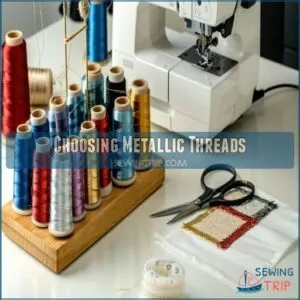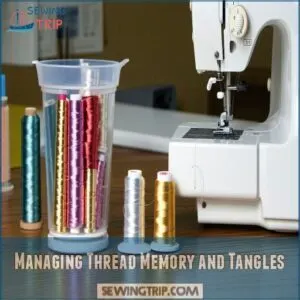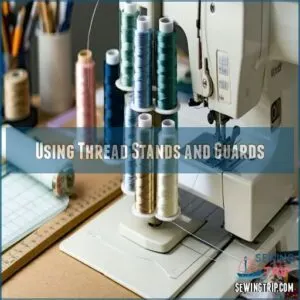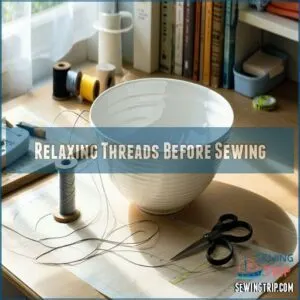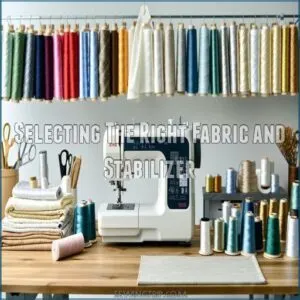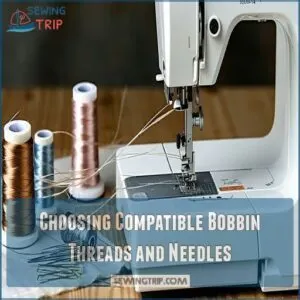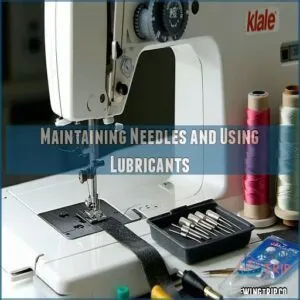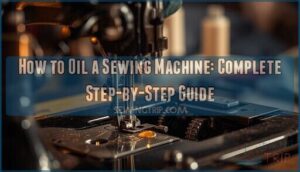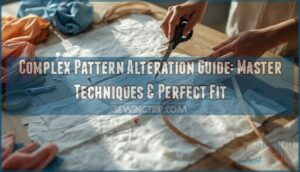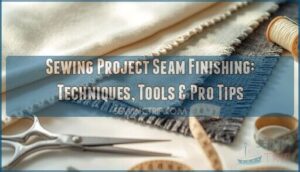This site is supported by our readers. We may earn a commission, at no cost to you, if you purchase through links.
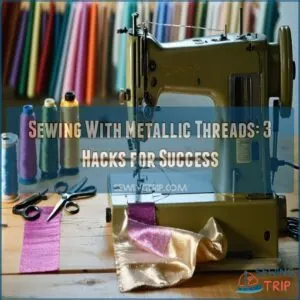
Slow your machine down – this isn’t a race, and these threads can be as temperamental as a cat in a bathtub. Keep your bobbin thread basic (white for light fabrics, grey for dark ones), and consider using a vertical spool holder to prevent tangling.
Proper tension adjustment is key, and a touch of thread lubricant can work wonders. Once you’ve mastered these, you’ll discover a whole world of dazzling decorative possibilities that’ll make your projects truly shine.
Table Of Contents
Key Takeaways
- You’ll need specialized equipment: use a metallic/topstitch needle (size 90/14), a vertical spool holder, and thread lubricant to prevent tangling and breakage.
- Keep your machine’s tension low (2-3) and sew at slower speeds to prevent thread breakage and ensure smooth stitching with metallic threads.
- Use high-quality metallic threads with rayon or nylon cores, and pair them with lightweight bobbin threads to reduce bulk and prevent puckering.
- Let your metallic threads relax before sewing by unwinding them in a bowl, and use thread nets or guards to control unwanted tangles and curls.
Choosing Metallic Threads
You’ll want to select the right metallic thread for your project, considering both its core type (like rayon or polyester) and how it behaves on your machine.
This guarantees your stitches look fantastic and you don’t end up with a tangled, glittery mess.
High-quality Thread Selection
Choosing the best metallic thread means skipping the cheap stuff. Go for high-quality metallic thread with smooth yarn texture and durable core materials like rayon or nylon.
Reputable brands craft threads that sparkle without snapping. Balance thread weight with fiber types for stunning results.
To achieve professional-looking embroidery, consider visiting embroidery education resources. Color choices? Pick vibrant metallic thread brands that pop but don’t compromise performance!
Thread Core Types and Benefits
Regarding metallic threads, understanding core material can save you frustration. A high-quality metallic thread with a rayon core outperforms polyester cores, reducing thread stretch and thread breakage.
Understanding the [computer Core](https://forums.tomshardware.com/threads/what-is-core-and-thread.
227086/) and thread concepts is essential for optimizing thread performance. Here’s why to care:
- Rayon core: Reduces tension issues.
- Polyester core: More prone to snags.
- Fiber blends: Provide smoother stitching.
- Yarn construction: Impacts thread quality.
- Weave patterns: Affect durability.
Spool Handling and Preparation
Flat metallic threads hate tangles, and let’s be honest, so do you. Use vertical holders or a thread stand to manage unruly spools. Trying DIY? A styrofoam cup works!
For ribbon-like threads, let them relax in a bowl before sewing. Want smoother stitching? Slip on a thread net or adjust the spool tension. Understanding the thread types is essential for achieving professional results.
| Issue | Solution | Tool |
|---|---|---|
| Tangling Threads | Use vertical holders | Thread Stand |
| Curling Spools | Let threads relax | Bowl or Cup |
| Loose Winding | Control spool tension | Thread Net |
Thread Preparation Tips
Preparing metallic threads might seem tricky, but with a few simple steps, you’ll keep tangles and curls under control.
Handle your spools carefully, and let tools like thread stands and guards work their magic for smoother sewing.
Managing Thread Memory and Tangles
Metallic threads can tangle like holiday lights—frustrating but fixable. Master metallic thread care with these tips:
Understanding thread strength is essential for achieving professional results with metallic threads.
- Relax threads using a large cup or bowl to reduce thread memory.
- Prevent tangles by wrapping spools with silicon thread savers.
- Control thread unwinding by weaving it through a multi-slot thread stand.
- Manage fiber tension with lightweight bobbin threads to avoid breakages.
Using Thread Stands and Guards
Tangled metallic threads? That’s where a thread stand or guard saves the day.
Use a vertical thread stand for smoother thread flow and fewer kinks. Pair it with a Wonder Guard thread guard or thread net to tame unruly spools.
For best results, consider investing in a thread stand to organize your workspace.
Here’s a quick comparison:
| Accessory | Benefit | Ideal Use Case |
|---|---|---|
| Thread Stand | Smooth thread flow | Metallic threads |
| Wonder Guard | Curl/tangle prevention | Metallic and delicate |
| Thread Net | Stabilizes thread feed | Ribbon-like threads |
Relaxing Threads Before Sewing
If your thread feels like it’s got a mind of its own, give it some room to relax.
Use a large bowl or cup to let the spool unwind freely, helping with thread relaxation and tangle prevention.
This simple trick conditions the fibers, making thread winding smoother and reducing thread breakages.
Good spool management equals better thread care!
Top 3 Sewing Essentials
When sewing with metallic threads, having the right tools makes all the difference. From the perfect needle to handy thread-saving gadgets, these essentials guarantee a smoother, frustration-free sewing experience.
1. Metallic Sewing Machine Needles Size
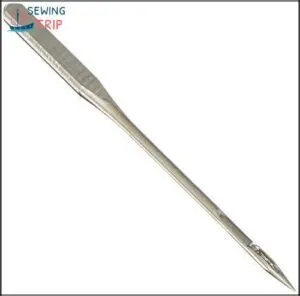
Getting the right needle can make or break your metallic thread project.
A size 90/14 topstitch or metallic needle is your go-to for minimizing thread stress and breakage.
Its elongated eye reduces friction, making those finicky metallics behave.
For heavy-duty tasks or longarm machines, snag a size 16 needle.
And here’s a tip: always start with a fresh needle—dull ones wreak havoc on metallic threads.
Think of it as giving your project its best shot at sparkling success!
Best For: Crafters working with metallic or specialty threads who want smooth, stress-free stitching.
- Elongated eye minimizes thread friction and prevents breakage.
- Works well with metallic, heavy, and specialty threads.
- Reduces stress on delicate or poor-quality threads.
- Requires frequent replacement to avoid dullness.
- Not ideal for use with standard threads.
- Higher cost compared to regular needles.
2. Metallic Embroidery Thread Kit Assortment
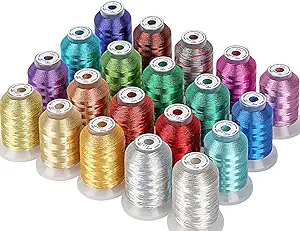
A metallic embroidery thread kit assortment is your best friend when diving into metallic sewing.
Look for kits offering an array of colors with high-quality threads featuring a strong core, like nylon, and coatings to prevent fraying or breakage.
These kits often include matching bobbin threads, saving you time and headaches.
Bonus tip: try a small kit first to test compatibility with your machine.
It’s like finding the perfect shade of lipstick—once you do, you’re unstoppable and ready to shine!
Best For: Crafters and hobbyists who want durable, vibrant metallic threads for embroidery projects.
- Strong nylon core with coatings reduces breakage and fraying.
- Wide range of colors to match different projects.
- Comes with matching bobbin threads for convenience.
- Metallic threads can be tricky for beginners to work with.
- Slower sewing speeds needed to avoid common issues.
- May require special needles and machine adjustments.
3. Thread Spool Saver for Sewing
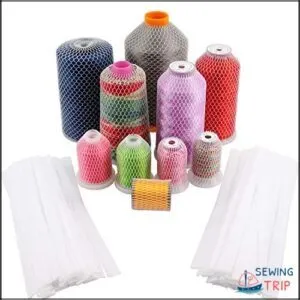
Thread spool savers are the unsung heroes of a neat sewing area.
These nifty silicone wraps stop metallic thread from unraveling or tangling, saving you headaches mid-project.
They’re flexible, reusable, and fit most home sewing spools without hogging storage space.
No one likes thread chaos, and spool savers keep everything tidy and stress-free.
Bonus? They come in fun colors, adding a little flair to your setup.
Whether you’re a beginner or pro, they’re an essential tool for smooth stitching adventures, and using thread spool savers can make a big difference.
Best For: Sewing enthusiasts who want a simple, reusable solution to keep threads tidy and avoid tangles during projects.
- Easy to use and fits most home sewing spool sizes.
- Keeps thread neat and organized, preventing unwinding and tangling.
- Made from durable, reusable silicone material available in fun colors.
- May not fit oversized or industrial-sized spools.
- Limited to home-use spools, not ideal for professional setups.
- Requires manual application on each spool, adding an extra step to setup.
Machine Settings Techniques
Getting your machine settings right can make or break your success with metallic threads.
From adjusting tension to slowing down your speed, these tweaks will keep you stitching smoothly without the dreaded thread snaps.
Adjusting Machine Speed and Tension
Now that you’ve got your gear ready, let’s tweak those sewing machine settings.
Metallic threads break easily, so lower the thread tension to about 2-3 and slow down your sewing speed.
This reduces friction and tension problems. Think of it like driving in rain—smooth and steady avoids disasters.
Adjust patiently, and you’ll minimize thread breakages. The assistant recommends practicing first!
Sewing Techniques for Metallic Threads
Keeping your speed steady and low makes sewing with metallic threads a smoother ride.
Metallic thread weaving works best with longer, consistent stitches to reduce friction.
Pair this with proper thread tension tips—try loosening it slightly to prevent snapping.
Understanding Sewing Polyester techniques can also be beneficial for working with delicate fabrics.
For added control, use spring-loaded presser feet, which help create flawless metallic thread stitching without extra stress on your fabric.
Optimizing Stitch Length and Thread Beauty
Experiment with stitch length to make metallic thread shine. Longer stitches (3-4mm) reduce fabric friction and thread tension, showcasing thread visibility and beauty enhancement.
Shorter stitches risk breaking the thread. Pay attention to fabric interaction—delicate fabrics might need even gentler adjustments.
Nail metallic thread sewing by balancing length control with metallic thread techniques for flawless, shimmering results. It’s pure stitching magic!
Successful Sewing Strategies
You’ve got to set yourself up for success when working with metallic threads, and that starts with the right tools and materials.
From stabilizers that keep your fabric steady to needles that glide effortlessly, a few smart choices can save you hours of frustration.
Selecting The Right Fabric and Stabilizer
Choosing fabric for metallic thread can feel like traversing a maze, but it’s easier than you think! Pick smooth, lightweight fabrics like silk or quilting cotton. Pair them with stabilizer materials that fit the fabric type and thread weight.
Understanding sewing stitch types is also vital for achieving professional results. Here’s your checklist:
- Avoid textured fabrics (like corduroy).
- Tear-away stabilizers work well.
- Match stabilizer to sewing surfaces.
- Look for interfacing options stopping thread damage.
Choosing Compatible Bobbin Threads and Needles
When sewing with metallic threads, you’ll need a lighter weight bobbin thread to reduce bulk and prevent breakage.
Try using a quilting thread in the bobbin while keeping your metallic thread on top. For best results, pair these with a size 90/14 metallic needle or jersey needle.
Understanding thread weights is essential for achieving the right balance. Don’t forget to loosen your sewing tension – it’s the secret to smooth, hassle-free metallic stitching.
Maintaining Needles and Using Lubricants
Now that you’ve got your bobbin and needles sorted, let’s talk about keeping your setup running smoothly.
Replace your metallic thread needle after 8 hours of sewing – dull needles can shred your threads.
A drop of Thread Lubrication or Sewing Smoothers on your needle prevents friction.
Clean your Klasse Metallic Needles between projects with rubbing alcohol to remove buildup and guarantee Fray Prevention.
Frequently Asked Questions (FAQs)
Can I use metallic thread in a sewing machine?
90% of sewists can successfully use metallic thread in their machines with the right setup. You’ll need special needles (90/14 topstitch), proper tension settings (2-3), and slower speeds for the best results.
What needle should I use with metallic thread?
You’ll need a 90/14 topstitch or metallic needle for home sewing machines.
If you’re using a longarm machine, go with a size 16 needle.
Always start with a fresh needle to prevent snags.
What tension should I use for metallic thread?
Many sewists struggle with tension settings.
You’ll want to lower your top thread tension to 2-3 for flat metallic threads.
For free-motion work, drop it even lower to 0-2 for smooth, beautiful results.
How to work with metallic thread?
Use a thread stand and topstitch needle, lower your tension to 2-3, and sew slowly.
Add thread lubricant if needed.
Keep the thread straight and untangled for best results with metallic materials.
How do I fix puckering when sewing metallic thread?
Loosen your top thread tension and switch to a lighter weight bobbin thread.
You’ll need to adjust stitch length to longer settings and slow down your sewing speed to prevent fabric from bunching up.
Can metallic threads be used for hand embroidery?
While they’re trickier than regular threads, you’ll love using metallic threads for hand embroidery.
Choose threads with flexible cores, work slowly, and you’ll create stunning sparkly designs that catch everyone’s eye.
What fabrics should I avoid with metallic threads?
You’ll want to steer clear of delicate fabrics like chiffon or silk, as well as very stretchy knits.
These can pucker and snag easily.
Stick to medium-weight wovens for best results.
How long do metallic threads last in storage?
Like fine wine, metallic threads can last 5-10 years when you store them properly.
Keep them in a cool, dry place away from direct sunlight and humidity to prevent tarnishing or deterioration.
Does washing affect the shine of metallic threads?
Washing can dull metallic thread’s shine over time.
To maintain the sparkle, use cold water and gentle detergents.
Hand washing works best, but if machine washing’s necessary, pop items in a mesh bag first.
Conclusion
Don’t let the glitz and glamour of metallic threads intimidate you!
With the right tools and techniques, sewing with metallic threads becomes second nature.
Remember to take it slow, keep your machine properly adjusted, and use quality materials.
Whether you’re creating holiday decorations or adding sparkle to everyday projects, these tips will help you master metallic thread sewing.
Soon you’ll be confidently incorporating these eye-catching accents into your work, making pieces that truly stand out from the crowd.

